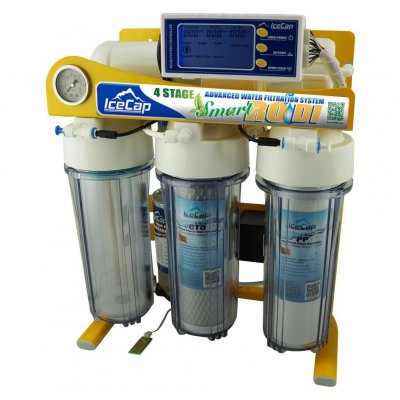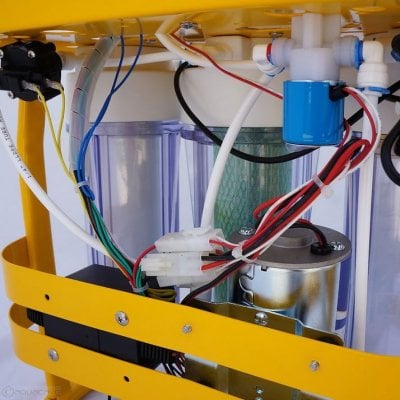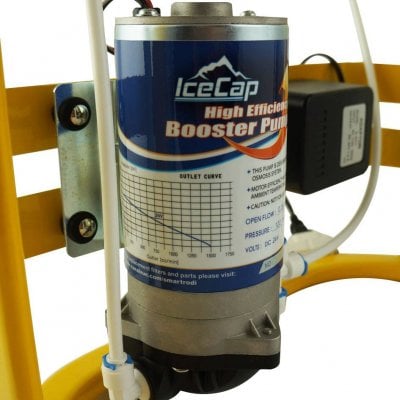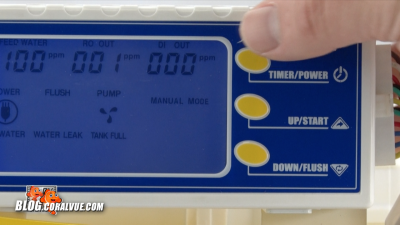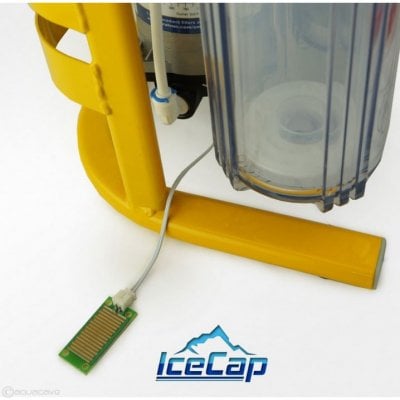All images property of Ice Cap (Coralvue) and used here under fair use guidelines, as they best demonstrate the product being discussed.
Smart – now there is a moniker often used thus far into the 21st century. First our phones became smart, now our watches, light bulbs, home security devices and even our door bells have reached the genius level. Not long ago, I purchased a smart bathroom scale, that tracks your weight and updates you on muscle mass, body fat content and recommended caloric intake. Everything is smart these days, even the equipment that keeps our aquariums healthy. If there was one device I thought would take decades (at best) to carry the smart moniker, it was most certainly RODI (Reverse Osmosis De-ionizing) filters. There certainly isn’t anything not-smart about a RODI unit, in fact it’s one of the smartest investments a reef keeper can make. Yet as I sit here at my iMac staring into the other side of my fish-room, where the Ice Cap Smart RODI unit works to fill my 50 gallon RODI water holding tank, I realize that with some innovation just about anything can be reinvented, unleashing an enticing set of new features.
I have had my eye on the Ice Cap Smart RODI for a while now. I typically replace my RODI unit every 3-5 years and the allure of a smart RODI was something I couldn’t ignore. My primary complaint about my current RODI (a BRS 6-stage unit) is that it creates water very slowly, drip by painfully slow drip. Since it doesn’t have a booster pump, the RODI relies solely on the output pressure of my home’s water pump and pressure tank. When the sink, shower, toilet or garden hose isn’t running, that’s typically pretty good as the pressure tank maintains a constant PSI of 50 when it isn’t under heavy load. Though, life with a four-year old means life running water. In between loads of laundry, bathes, showers and outdoor summer play, it’s rare that the RODI isn’t competing with something else for water pressure.
Yes, I could have installed a $ 179-dollar booster pump on my current unit, but isn’t shelling out $ 400 on something smart (that clearly sports a cool high-tech look) way more fun?
The Ice Cap Smart RODI:
First, the smart RODI from Ice Cap comes in one primary flavor, 100 gpd (gallons per day). Like other RODI units, this simply means that the unit can make 100 gallons of ultra-pure freshwater in 24 hours. My previous unit made 70 gallons per-day and was quite under-sized for the sheer amount of saltwater I maintain. The catch with the smart RODI is the 100 gpd or more tagline in Ice Cap’s advertising. The unit is potentially capable of making more than 100 gpd under the right conditions, using the system’s built in, digital management tools.
The first thing I noticed when I un-packaged the smart RODI was a green leaf and smart green solutions tag on the box. At first, I thought this was laughable. How could a device that uses five gallons of tap water to create one gallon of pure be considered green? It wasn’t until I had the unit up and running that I realized Ice Cap wasn’t just being funny.
The smart RODI is a nice looking unit and certainly outpaces the competition with its top-notch aesthetics and durable construction. The entire RODI is framed in a tough, yellow steel frame and just picking it up screams, “This is not a toy.” Unlike traditional RODI units (even my old unit, which had an integrated TDS meter and filter monitor) the smart RODI has lots of electrical wires and sensors running everywhere. Everything is pre-installed and clipped into place, right down to the Ice Cap RODI controller that rests at the unit’s top. There is even a pre-installed leak detector and booster pump, both features not commonly found pre-installed on RODI units, even premium ones. Upon inspection, it’s easy to see how Ice Cap justifies their $ 400 price tag, as this RODI unit has everything. Even after a close inspection, I was still wondering, what makes it smart? Can I check my email, the weather or snapchat?
Smart features:
The smart RODI assembles and installs much like a traditional unit. It’s once the sediment filter and carbon block are in place (and the other canisters sealed into place, empty) that the differences come to light. The smart RODI cannot function without electrical power. Everything the RODI does is directed by the Ice Cap controller. Yes you can connect it to a water supply and turn the water supply on, but the RODI will simply fill up the filtration canisters and no output will exit either the waste or pure water lines. In fact, for the pre-filter flush (which consists of having just the carbon block and sediment filter installed) the controller quickly recognized that the membrane and DI canister were absent and proceeded to automatically begin the 15-minute pre-filter flush. Ice Cap recommends a pre-filter flush, so that the membrane and DI canister don’t become saturated with carbon dust and excess sediment rolling off a dry sediment cartridge.
The controller monitors incoming water pressure and activates the booster pump (which creates more pressure and thus increases water output) as needed. Once the initial flush is completed, the unit kicks itself off and allows for the installation of the membrane and DI cartridge.
For this flush, I had to access the timer mode. Every time the unit boots up it completes a short five-minute pre-flush. During this time the booster pump doesn’t become active and the goal is a simple membrane flush not unlike that done on a traditional RODI (by opening a fitting that allows water to quickly access the membrane). The controller has control over valves that open and shut various canister pathways, so there is no turning a fitting during the flush.
The aquarist has several options when using the smart RODI. Manual mode will make water until the controller senses back-pressure, meaning the vessel being filled is full. At that point, it will shut both the waste and pure water lines off, thus preventing an over-flow. Timer mode lets the aquarist run the RODI for a pre-set amount of time, then shuts it off. If the RODI senses back-pressure signaling a full container before the time runs out, it automatically shuts itself off. The modes are easy to access and the controller is intuitive.
A small leak detector can be placed in the vicinity of a potential leak, should the RODI fail to shut itself off and water overflows. The second water touches the leak detector, the entire unit shuts down, sealing off both the waste and pure water lines. I tested it and it works.
Ice Cap’s controller doesn’t just make using the RODI practically effortless (it will even remind you if you haven’t turned a water source on) it also displays information about RODI performance. The controller notifies the aquarist if the pump is being used and also sports a digital pressure gauge which shows live readings of water pressure through the unit. Also there is a digital TDS meter that displays incoming and outgoing water TDS, and the TDS of water leaving the RODI membrane and the DI cartridge. There is also an analogue, liquid filled pressure gauge for comparison.
By far, this is the easiest to use RODI unit I’ve ever seen and likely the highest tech RODI solution on the market. If any aquarists have been put off by the complex appearance of a RODI unit, this ensures that the experience won’t be overly challenging.
A potential Achilles heel:
Luxury cars, new computers and the latest cell phones all have the same Achilles heel as the smart RODI. The more technology and functionality you cram into something, the more points of potential operation failure. While having an electronic controller that manages nearly every aspect of RODI operation (aside from turning on the water) is awfully handy, it also presents multiple areas of failure, and thus confusion, especially for RODI newbies. For example, the first time I set the smart RODI up and began flushing the membrane, I noticed a drip by drip leak on the line connecting the booster pump to the rest of the filter. In order to fix it, I needed to remove the line and connection, add some thread tape and tighten it up. On a normal RODI this would be considered routine set-up and maintenance and likely not cause any issue whatsoever. In the process of fixing the leak, I accidently loosened one of the power transmission lines that sends power and communication to the rest of the unit. Suddenly, I had a huge paper weight, as the controller would not turn on, thus the unit would do nothing.
On a typical RODI unit, electronics are optional. Yes, you can add a monitor to determine when filters need changed (most simply use a countdown timer, much like a fridge’s water filter replacement reminder does) or you can run a TDS meter, etc. Yet if you turn on a water source, the RODI makes water, with or without any electronics. The smart RODI requires the controller to be operational, as otherwise the lines that release pure and waste water are simply held shut. They open, only when done so by the electronic, digital controller.
It took me a few minutes to check over all the wiring (there is a considerable amount) and determine the cause of the fault. Once I did, the RODI kicked back on, leak fixed and continued with the membrane flush. For a seasoned aquarist, this isn’t much of a concern since most of us are familiar with RODI units and the electronics that can be added to them. However, the entire premise of the smart RODI is to be a device that new, novice or RODI unfamiliar aquarists can easily connect and use, with little intervention. If wires easily become loosened during routine maintenance, it could leave the user confused and eventually cause them to think they have a faulty device.
Another potential source of confusion is the leak detector. RODI leak detectors I’ve used in the past are pretty simple (and thus pretty useless). They simply sound an alarm if water is detected wherever the leak detector is placed. The smart RODI has a much more advanced leak detector, which is a good thing, but something aquarists need to understand. Instead of just sounding an audible alarm if water is detected, this little moisture sensing chip shuts the entire RODI off (controller and all) until it no longer senses moisture. That’s a good thing, in that it could prevent serious flood damage, but it’s important users know to install it somewhere that water won’t spill or drip during routine maintenance etc. Otherwise, they will be mystified as to why their RODI isn’t turning on.
The highest tech RODI ever?
I would be willing to argue that Ice Cap’s Smart RODI is the most technologically advanced unit available to average aquarists. RODI technology hasn’t leaped this far forward in a long time and Ice Cap’s innovations could easily evolve into RODI units that connect to our phones via wi-fi, giving aquarists the ability to make pure water on the go. Yes, we’ve gotten in-line TDS monitoring, filter replacement reminders and even some electronic performance monitoring. The smart RODI takes it many steps further, by implementing a controller that essentially ensures you’re getting the best performance out of your RODI.
Even better, the smart RODI is by far the fastest pure water generator I’ve ever used. My old RODI took about 5-6 hours to create 32 gallons of purified water. Using the smart RODI, the same amount took about 3 hours to create, nearly half the amount of time. I imagine it’s a result of both the powerful booster pump (which keeps the RODI’s water pressure between 60-70 at all times) and the management protocols of the controller. Oh, and back to the green thing. Like I said, I was a bit shocked that a RODI unit would advertise itself as green. Using my previous RODI, I could fill a 60+ gallon rain barrel with waste, while making just enough water for a small water change. In making 32 gallons of water, the smart RODI produced a bit less than 40 gallons of waste. I assume it’s a result of the higher speed of pure water creation that results in less waste water. While it can still be argued that RODI use (in and of itself) isn’t a green practice (since it wastes more water than it creates) that certainly is an improvement. Since the controller can shut the unit off after a specified time period, if a container is full, etc – it ensures waste water won’t be created overflowing a container or making more water than an aquarist needs. All of those features save water and increase efficiency.
Overall, the smart RODI is a high-tech, easy to use device that most certainly should make RODI filtration more attractive to a variety of aquarists. If you’re in need of a new RODI, on the fence about implementing one or just want a cool reef tech toy to play with, the smart RODI won’t disappoint.
Smart – now there is a moniker often used thus far into the 21st century. First our phones became smart, now our watches, light bulbs, home security devices and even our door bells have reached the genius level. Not long ago, I purchased a smart bathroom scale, that tracks your weight and updates you on muscle mass, body fat content and recommended caloric intake. Everything is smart these days, even the equipment that keeps our aquariums healthy. If there was one device I thought would take decades (at best) to carry the smart moniker, it was most certainly RODI (Reverse Osmosis De-ionizing) filters. There certainly isn’t anything not-smart about a RODI unit, in fact it’s one of the smartest investments a reef keeper can make. Yet as I sit here at my iMac staring into the other side of my fish-room, where the Ice Cap Smart RODI unit works to fill my 50 gallon RODI water holding tank, I realize that with some innovation just about anything can be reinvented, unleashing an enticing set of new features.
I have had my eye on the Ice Cap Smart RODI for a while now. I typically replace my RODI unit every 3-5 years and the allure of a smart RODI was something I couldn’t ignore. My primary complaint about my current RODI (a BRS 6-stage unit) is that it creates water very slowly, drip by painfully slow drip. Since it doesn’t have a booster pump, the RODI relies solely on the output pressure of my home’s water pump and pressure tank. When the sink, shower, toilet or garden hose isn’t running, that’s typically pretty good as the pressure tank maintains a constant PSI of 50 when it isn’t under heavy load. Though, life with a four-year old means life running water. In between loads of laundry, bathes, showers and outdoor summer play, it’s rare that the RODI isn’t competing with something else for water pressure.
Yes, I could have installed a $ 179-dollar booster pump on my current unit, but isn’t shelling out $ 400 on something smart (that clearly sports a cool high-tech look) way more fun?
The Ice Cap Smart RODI:
First, the smart RODI from Ice Cap comes in one primary flavor, 100 gpd (gallons per day). Like other RODI units, this simply means that the unit can make 100 gallons of ultra-pure freshwater in 24 hours. My previous unit made 70 gallons per-day and was quite under-sized for the sheer amount of saltwater I maintain. The catch with the smart RODI is the 100 gpd or more tagline in Ice Cap’s advertising. The unit is potentially capable of making more than 100 gpd under the right conditions, using the system’s built in, digital management tools.
The first thing I noticed when I un-packaged the smart RODI was a green leaf and smart green solutions tag on the box. At first, I thought this was laughable. How could a device that uses five gallons of tap water to create one gallon of pure be considered green? It wasn’t until I had the unit up and running that I realized Ice Cap wasn’t just being funny.
The smart RODI is a nice looking unit and certainly outpaces the competition with its top-notch aesthetics and durable construction. The entire RODI is framed in a tough, yellow steel frame and just picking it up screams, “This is not a toy.” Unlike traditional RODI units (even my old unit, which had an integrated TDS meter and filter monitor) the smart RODI has lots of electrical wires and sensors running everywhere. Everything is pre-installed and clipped into place, right down to the Ice Cap RODI controller that rests at the unit’s top. There is even a pre-installed leak detector and booster pump, both features not commonly found pre-installed on RODI units, even premium ones. Upon inspection, it’s easy to see how Ice Cap justifies their $ 400 price tag, as this RODI unit has everything. Even after a close inspection, I was still wondering, what makes it smart? Can I check my email, the weather or snapchat?
Smart features:
The smart RODI assembles and installs much like a traditional unit. It’s once the sediment filter and carbon block are in place (and the other canisters sealed into place, empty) that the differences come to light. The smart RODI cannot function without electrical power. Everything the RODI does is directed by the Ice Cap controller. Yes you can connect it to a water supply and turn the water supply on, but the RODI will simply fill up the filtration canisters and no output will exit either the waste or pure water lines. In fact, for the pre-filter flush (which consists of having just the carbon block and sediment filter installed) the controller quickly recognized that the membrane and DI canister were absent and proceeded to automatically begin the 15-minute pre-filter flush. Ice Cap recommends a pre-filter flush, so that the membrane and DI canister don’t become saturated with carbon dust and excess sediment rolling off a dry sediment cartridge.
The controller monitors incoming water pressure and activates the booster pump (which creates more pressure and thus increases water output) as needed. Once the initial flush is completed, the unit kicks itself off and allows for the installation of the membrane and DI cartridge.
For this flush, I had to access the timer mode. Every time the unit boots up it completes a short five-minute pre-flush. During this time the booster pump doesn’t become active and the goal is a simple membrane flush not unlike that done on a traditional RODI (by opening a fitting that allows water to quickly access the membrane). The controller has control over valves that open and shut various canister pathways, so there is no turning a fitting during the flush.
The aquarist has several options when using the smart RODI. Manual mode will make water until the controller senses back-pressure, meaning the vessel being filled is full. At that point, it will shut both the waste and pure water lines off, thus preventing an over-flow. Timer mode lets the aquarist run the RODI for a pre-set amount of time, then shuts it off. If the RODI senses back-pressure signaling a full container before the time runs out, it automatically shuts itself off. The modes are easy to access and the controller is intuitive.
A small leak detector can be placed in the vicinity of a potential leak, should the RODI fail to shut itself off and water overflows. The second water touches the leak detector, the entire unit shuts down, sealing off both the waste and pure water lines. I tested it and it works.
Ice Cap’s controller doesn’t just make using the RODI practically effortless (it will even remind you if you haven’t turned a water source on) it also displays information about RODI performance. The controller notifies the aquarist if the pump is being used and also sports a digital pressure gauge which shows live readings of water pressure through the unit. Also there is a digital TDS meter that displays incoming and outgoing water TDS, and the TDS of water leaving the RODI membrane and the DI cartridge. There is also an analogue, liquid filled pressure gauge for comparison.
By far, this is the easiest to use RODI unit I’ve ever seen and likely the highest tech RODI solution on the market. If any aquarists have been put off by the complex appearance of a RODI unit, this ensures that the experience won’t be overly challenging.
A potential Achilles heel:
Luxury cars, new computers and the latest cell phones all have the same Achilles heel as the smart RODI. The more technology and functionality you cram into something, the more points of potential operation failure. While having an electronic controller that manages nearly every aspect of RODI operation (aside from turning on the water) is awfully handy, it also presents multiple areas of failure, and thus confusion, especially for RODI newbies. For example, the first time I set the smart RODI up and began flushing the membrane, I noticed a drip by drip leak on the line connecting the booster pump to the rest of the filter. In order to fix it, I needed to remove the line and connection, add some thread tape and tighten it up. On a normal RODI this would be considered routine set-up and maintenance and likely not cause any issue whatsoever. In the process of fixing the leak, I accidently loosened one of the power transmission lines that sends power and communication to the rest of the unit. Suddenly, I had a huge paper weight, as the controller would not turn on, thus the unit would do nothing.
On a typical RODI unit, electronics are optional. Yes, you can add a monitor to determine when filters need changed (most simply use a countdown timer, much like a fridge’s water filter replacement reminder does) or you can run a TDS meter, etc. Yet if you turn on a water source, the RODI makes water, with or without any electronics. The smart RODI requires the controller to be operational, as otherwise the lines that release pure and waste water are simply held shut. They open, only when done so by the electronic, digital controller.
It took me a few minutes to check over all the wiring (there is a considerable amount) and determine the cause of the fault. Once I did, the RODI kicked back on, leak fixed and continued with the membrane flush. For a seasoned aquarist, this isn’t much of a concern since most of us are familiar with RODI units and the electronics that can be added to them. However, the entire premise of the smart RODI is to be a device that new, novice or RODI unfamiliar aquarists can easily connect and use, with little intervention. If wires easily become loosened during routine maintenance, it could leave the user confused and eventually cause them to think they have a faulty device.
Another potential source of confusion is the leak detector. RODI leak detectors I’ve used in the past are pretty simple (and thus pretty useless). They simply sound an alarm if water is detected wherever the leak detector is placed. The smart RODI has a much more advanced leak detector, which is a good thing, but something aquarists need to understand. Instead of just sounding an audible alarm if water is detected, this little moisture sensing chip shuts the entire RODI off (controller and all) until it no longer senses moisture. That’s a good thing, in that it could prevent serious flood damage, but it’s important users know to install it somewhere that water won’t spill or drip during routine maintenance etc. Otherwise, they will be mystified as to why their RODI isn’t turning on.
The highest tech RODI ever?
I would be willing to argue that Ice Cap’s Smart RODI is the most technologically advanced unit available to average aquarists. RODI technology hasn’t leaped this far forward in a long time and Ice Cap’s innovations could easily evolve into RODI units that connect to our phones via wi-fi, giving aquarists the ability to make pure water on the go. Yes, we’ve gotten in-line TDS monitoring, filter replacement reminders and even some electronic performance monitoring. The smart RODI takes it many steps further, by implementing a controller that essentially ensures you’re getting the best performance out of your RODI.
Even better, the smart RODI is by far the fastest pure water generator I’ve ever used. My old RODI took about 5-6 hours to create 32 gallons of purified water. Using the smart RODI, the same amount took about 3 hours to create, nearly half the amount of time. I imagine it’s a result of both the powerful booster pump (which keeps the RODI’s water pressure between 60-70 at all times) and the management protocols of the controller. Oh, and back to the green thing. Like I said, I was a bit shocked that a RODI unit would advertise itself as green. Using my previous RODI, I could fill a 60+ gallon rain barrel with waste, while making just enough water for a small water change. In making 32 gallons of water, the smart RODI produced a bit less than 40 gallons of waste. I assume it’s a result of the higher speed of pure water creation that results in less waste water. While it can still be argued that RODI use (in and of itself) isn’t a green practice (since it wastes more water than it creates) that certainly is an improvement. Since the controller can shut the unit off after a specified time period, if a container is full, etc – it ensures waste water won’t be created overflowing a container or making more water than an aquarist needs. All of those features save water and increase efficiency.
Overall, the smart RODI is a high-tech, easy to use device that most certainly should make RODI filtration more attractive to a variety of aquarists. If you’re in need of a new RODI, on the fence about implementing one or just want a cool reef tech toy to play with, the smart RODI won’t disappoint.



